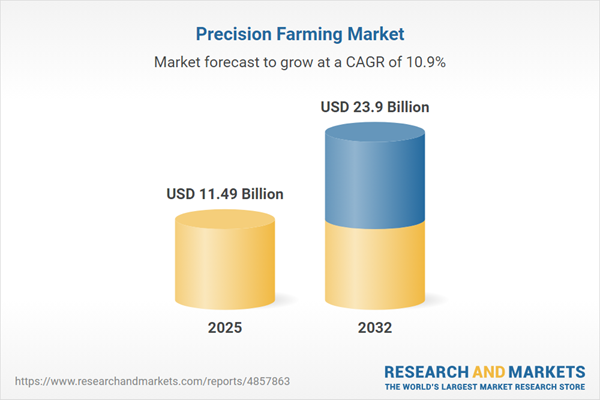Speak directly to the analyst to clarify any post sales queries you may have.
Precision farming is transforming the global agriculture landscape by integrating advanced digital technologies, enabling growers and agribusinesses to optimize operations, improve resource efficiency, and enhance crop productivity. The sector’s evolution signals a clear move toward data-driven, sustainable, and resilient farming practices.
Market Snapshot: Precision Farming Market Size and Growth
The Precision Farming Market grew from USD 10.41 billion in 2024 to USD 11.49 billion in 2025 and is projected to continue expanding at a CAGR of 10.94%, reaching USD 23.90 billion by 2032. Investments in automation, analytics, and remote sensing, coupled with rising demand for sustainable food systems, have accelerated adoption across diverse agricultural landscapes.
Scope & Segmentation
- Offering: Hardware (automation and control machinery, data processing and computing hardware, sensing and monitoring devices), Services (managed services, professional services), and Software (data analytics platforms, farm management software/FMS)
- Produce Type: Cereals and grains (barley, corn, rice, wheat), fruits and vegetables (apples, berries, citrus fruits, leafy greens, tomatoes), livestock, oilseeds and pulses (canola/rapeseed, lentils, soybean, sunflower), plantation crops
- Technology: Artificial intelligence and machine learning, GPS/GNSS, Internet of Things, remote sensing and imagery
- Farm Size: 100–500 acres, less than 100 acres, more than 500 acres
- Application: Crop scouting and protection (disease detection, pest monitoring, weed detection), farm fleet and asset management, field mapping and zonation, irrigation and water management (crop water stress detection, scheduling, variable rate irrigation), seeding and planting (planter control, prescription generation), soil and nutrient management, yield monitoring and forecasting
- End-user: Agricultural co-operatives, company-owned/corporate farms, individual farmers, research institutions and universities
- Geography: Americas (North America: United States, Canada, Mexico; Latin America: Brazil, Argentina, Chile, Colombia, Peru), Europe Middle East & Africa (United Kingdom, Germany, France, Russia, Italy, Spain, Netherlands, Sweden, Poland, Switzerland, United Arab Emirates, Saudi Arabia, Qatar, Turkey, Israel, South Africa, Nigeria, Egypt, Kenya), and Asia-Pacific (China, India, Japan, Australia, South Korea, Indonesia, Thailand, Malaysia, Singapore, Taiwan)
- Leading Companies: AG Leader Technology, AGCO Corporation, Bayer AG, Cargill Incorporated, Climate LLC, CNH Industrial N.V., Corteva, CropX Technologies Ltd., Dickey-John Corporation, Farmers Edge, Grownetics, Hexagon AB, Deere & Company, Lindsay Corporation, METER Group, SENCROP, Topcon Positioning Systems, Trimble, Yara International, Tetra Laval, Kubota Corporation, TELUS Agriculture Solutions
Key Takeaways for Senior Decision-Makers
- Precision farming unifies IoT sensors, satellite imagery, and machine learning, enabling fact-based agricultural decisions for improved efficiency and sustainability.
- The competitive landscape is marked by strategic partnerships, acquisitions, and the emergence of modular solutions, which are increasing market accessibility across diverse farm sizes and operational models.
- Service-based business models, including pay-per-use and subscription frameworks, help operators manage capital expenditure and lower entry barriers, fueling broader adoption of digital agriculture tools.
- Regional adoption is driven by large-scale technology investments in the Americas, government incentives in Asia-Pacific, and pilot projects addressing food security and resource challenges in Africa and the Middle East.
- Effective supply chain and procurement strategies are essential due to evolving trade environments; local manufacturing and financing partnerships help stakeholders adapt to new cost structures.
Tariff Impact: Navigating Trade-Driven Challenges
Recent U.S. tariffs on imported precision farming equipment and components have affected sourcing strategies, increasing costs for manufacturers and farmers relying on global supply chains. These shifts have prompted a migration toward regional production and alternative financing methods, while also stimulating innovation and diversification among local technology providers.
Methodology & Data Sources
This report leverages a comprehensive methodology, incorporating both primary interviews with industry stakeholders and secondary research from public sources, proprietary market studies, and regulatory analysis. Data triangulation and validation by an expert advisory panel ensure accuracy and real-world applicability.
Why This Report Matters
- Enables executive leaders to benchmark trends and gain strategic foresight for investment and expansion in digital agriculture.
- Provides actionable insights for procurement, technology adoption, and regional market entry amid geopolitical and regulatory complexity.
- Delivers segmentation analysis vital for tailoring precision agriculture solutions to customer needs and future-proofing operations.
Conclusion
Precision farming is reshaping agricultural operations through data-centric technologies and adaptive strategies. Industry participants equipped with these findings can respond effectively to changing market conditions, harnessing innovation and collaboration to support long-term business growth.
Additional Product Information:
- Purchase of this report includes 1 year online access with quarterly updates.
- This report can be updated on request. Please contact our Customer Experience team using the Ask a Question widget on our website.
Table of Contents
3. Executive Summary
4. Market Overview
7. Cumulative Impact of Artificial Intelligence 2025
Companies Mentioned
The companies profiled in this Precision Farming market report include:- AG Leader Technology
- AGCO Corporation
- Bayer AG
- Cargill Incorporated
- Climate LLC
- CNH Industrial N.V.
- Corteva, Inc.
- CropX Technologies Ltd.
- Dickey-John Corporation
- Farmers Edge Inc.
- Grownetics, Inc.
- Hexagon AB
- Deere & Company
- Lindsay Corporation
- METER Group Inc.
- SENCROP
- Topcon Positioning Systems, Inc.
- Trimble Inc.
- Yara International ASA
- Tetra Laval Group
- Kubota Corporation
- TELUS Agriculture Solutions Inc.
Table Information
| Report Attribute | Details |
|---|---|
| No. of Pages | 180 |
| Published | November 2025 |
| Forecast Period | 2025 - 2032 |
| Estimated Market Value ( USD | $ 11.49 Billion |
| Forecasted Market Value ( USD | $ 23.9 Billion |
| Compound Annual Growth Rate | 10.9% |
| Regions Covered | Global |
| No. of Companies Mentioned | 23 |









